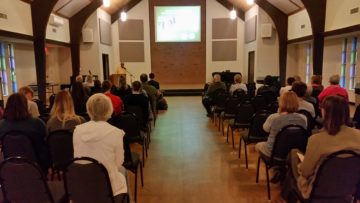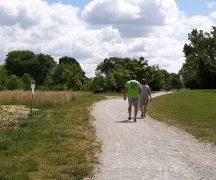By JAN LARSON McLAUGHLIN
BG Independent News
When Bowling Green Natural Resources Coordinator Chris Gajewicz took over at Wintergarden Park 17 years ago, he led Jennifer Windus, of ODNR, on a tour of the wild acres. He proudly showed her the woods and the prairie.
But Windus, now retired from ODNR, couldn’t help but notice all the non-native invasive plant species that were taking over the park. She zeroed in on the 4-foot tall impenetrable garlic mustard plants.
“You are the poster child for everything that can go wrong,” Gajewicz recalled her saying.
That was then.
After years of volunteers and staff pulling out the stubborn garlic mustard and other non-native invasive species, Wintergarden is a back-breaking success story.
“My sons can both identify garlic mustard while going 60 mph down the highway, and insist that we stop to pull it out,” Gajewicz said.
The efforts have worked, according to Windus, who is now president of Ohio Invasive Plants Council.
“I am really impressed with all the work you are doing,” she said last week after taking a tour of the park that she once called a “nightmare.”

Kuebeck Forum held in Simpson Garden Park Building
Windus returned to Bowling Green last week to talk about “Good Plants Gone Bad,” at the annual Kuebeck Forum offered by Bowling Green Parks and Recreation.
Many of the non-native invasive plant species look like beautiful wildflowers or vines to the inexperienced eye. But if left to roam, some can rapidly take over natural areas, Windus said. They reproduce quickly and have no natural controls.
“They out compete native species,” she explained. “Vines tend to creep and crawl over other vegetation and smother it out.”
There are more than 65 non-native plants that are documented as invasive in Ohio natural areas. Many of them were introduced in the U.S. for good reasons – like soil stability, medicinal, herbal, horticultural, or agricultural purposes.
But the fast growing plants then ended up creating problems of their own. Multiflora roses were introduced in the 1930s as a “living fence.” And Mexican bamboo was brought in as erosion control. However, “they choke out everything else,” Windus said.
On the most-wanted list of invasive species in Ohio are Garlic Mustard, Purple Loosestrife, Buckthorn, Multiflora Rose, Japanese Knotwood, Winter Creeper, Asiatic Bittersweet, Reed Canary Grass, and several types of Honeysuckle. Some become urgent economic and conservation challenges.
The impact of the plants can drastically change natural areas, such as:
- Displacing native plants and animals.
- Displacing rare species of plants.
- Reducing diversity.
- Forming dense monocultures.
- Altering the food web.
- Impacting human recreation.
As an example, Windus said that American toads suffer as much as a 50 percent increase in mortality when tadpoles develop in purple loosestrife instead of in cattail wetlands.
The problem plants can be found in natural areas and in manicured yards. Ideally, people would spot the non-native plant invasion quickly. “Try to get rid of them as soon as possible, before they take over,” she said.
The best control options vary with the type of plants. For some, pulling out by hand or cutting will work. Others may require herbicide, water level control, biological control, or even prescribed burning. The best control should be researched prior to using, she advised.
Windus advised that people not be discouraged by invasive species in their natural areas.
“It can be overwhelming. You might just throw your hands up and say, ‘I can’t do this. I’m just going to let it go,’” she said.
She suggested that people deal with one species at a time – to make the job more manageable.
“You have to pick your battles,” and put temporary blinders on for the other problems, Windus said.





